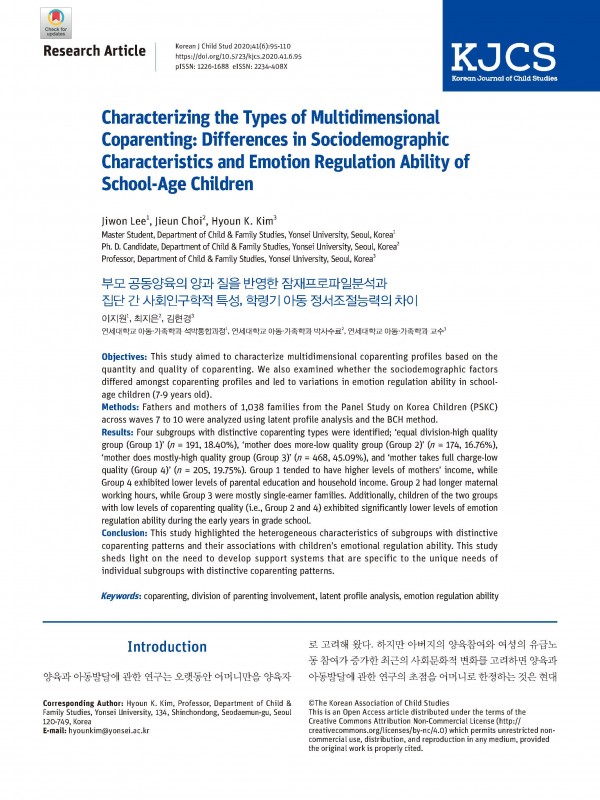논문 | 부모 공동양육의 양과 질을 반영한 잠재프로파일분석과 집단 간 사회인구학적 특성, 학령기 아동 정서조절능력의 차이
페이지 정보
작성자 관리자 작성일21-03-31 13:40 조회434회 댓글0건관련링크
본문
이지원, 최지은, 김현경. (2020). 부모 공동양육의 양과 질을 반영한 잠재프로파일분석과 집단 간 사회인구학적 특성, 학령기 아동 정서조절능력의 차이. 아동학회지, 41(6), 95-110.
DOI: https://doi.org/10.5723/kjcs.2020.41.6.95
ABSTRACT
Objectives
This study aimed to characterize multidimensional coparenting profiles based on the quantity and quality of coparenting. We also examined whether the sociodemographic factors differed amongst coparenting profiles and led to variations in emotion regulation ability in school-age children (7-9 years old).
Methods
Fathers and mothers of 1,038 families from the Panel Study on Korea Children (PSKC) across waves 7 to 10 were analyzed using latent profile analysis and the BCH method.
Results
Four subgroups with distinctive coparenting types were identified; ‘equal division-high quality group (Group 1)’ (n = 191, 18.40%), ‘mother does more-low quality group (Group 2)’ (n = 174, 16.76%), ‘mother does mostly-high quality group (Group 3)’ (n = 468, 45.09%), and ‘mother takes full charge-low quality (Group 4)’ (n = 205, 19.75%). Group 1 tended to have higher levels of mothers’ income, while Group 4 exhibited lower levels of parental education and household income. Group 2 had longer maternal working hours, while Group 3 were mostly single-earner families. Additionally, children of the two groups with low levels of coparenting quality (i.e., Group 2 and 4) exhibited significantly lower levels of emotion regulation ability during the early years in grade school.
Conclusion
This study highlighted the heterogeneous characteristics of subgroups with distinctive coparenting patterns and their associations with children’s emotional regulation ability. This study sheds light on the need to develop support systems that are specific to the unique needs of individual subgroups with distinctive coparenting patterns.
Keywords: coparenting, division of parenting involvement, latent profile analysis, emotion regulation ability
